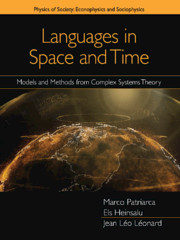Chapter 2 - Language and Languages
Published online by Cambridge University Press: 04 June 2020
Summary
While investigating a group of languages, one is interested in formulating aninsightful picture of their internal structure as well as of the relationsbetween the different languages in the group, reflecting the bit complexityand the social complexity aspects discussed briefly in the previous chapter.In order to proceed to a comparison and analysis of the languages, one needsto know how to define the differences between languages and group differentlanguages together in a way that best suits the observed differences. From amore general viewpoint, the picture thus obtained cannot be disentangledfrom the processes underlying the origin and evolution of languages,possibly from a common ancestor. These and other related topics will bediscussed in this part of the book.
Unless one is specifically interested in the comparison between differentscripts, language comparison methods are not applied to written texts but tothe actual spoken languages, by analyzing their phonetic transcriptions intothe IPA, the International Phonetic Alphabet
The transcription of a language into IPA is difficult work, requiring thefield linguists to make a faithful transcription of the spoken language evenup to its smallest phonetic details. In the case of unwritten languages,that is, languages that do not have a standard written form used by thenative speakers, their IPA transcription represents the only existingwritten source.
One of the relevant goals of an analysis of a linguistic database is toprovide a reliable picture of related languages. Some prototypicallinguistic scenarios used to describe language groups are the following:
• Linkage. A linkage of languages is a group oflanguages deriving from a protolanguage that has gradually branchedinto a number of (still) interacting languages. However, despite thecontinuous interactions, such languages keep differentiating moreand more into separate languages. The term ‘linkage’was introduced by Ross in his study of Western Oceanic languages(see Ross [1988]). A typical example of linkage is a group oflanguages born within a dialect continuum. Thelinkage formation process resembles parapatricspeciation in ecology, where species differentiatewhile remaining in contact with each other.
Information
- Type
- Chapter
- Information
- Languages in Space and TimeModels and Methods from Complex Systems Theory, pp. 9 - 40Publisher: Cambridge University PressPrint publication year: 2020
